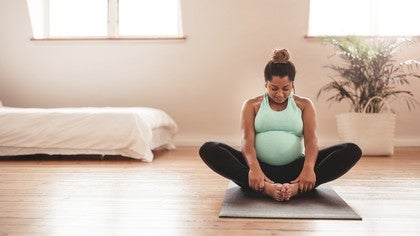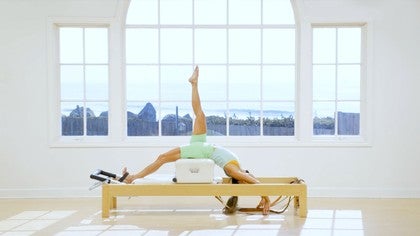
Six Moves for a Healthy Pelvic Floor
“It's time for us to have honest conversations about pelvic floor dysfunction: constipation, incontinence, painful sex, and a bunch of other stuff,” says Christi Idavoy, a Pilates instructor based in Costa Rica.
Idavoy rejects the idea of the pharmacy and late night TV advertisements being the main sources of information on pelvic health issues. While products such as laxatives and leak-proof undergarments are big business, they don’t fix the underlying causes of pelvic dysfunction. The good news is that these kinds of problems may respond to something a good Pilates instructor can offer: movement.
Movement Heals
“When our lifestyles include moving in all ranges of motion and relationships to gravity, we are more resilient,” says Idavoy, who is also a mom to a six-year old daughter.
Movement pros can help before, during, and especially after pregnancy with organ dysfunction or, more colloquially, with pelvic organs that don’t seem to be in the right place. “As Pilates instructors, we can't make a medical diagnosis of a pelvic organ dysfunction such as organ prolapse. But women know when things are ‘off.’ Either there’s a lot of tension and restriction, or it’s too wobbly,” says Idavoy.
“The pelvic floor is your deepest layer of abdominals. It’s a network of muscles that live at the base of your pelvis,” says Georgia Burns, a Pilates instructor and labor doula in Toronto, Ontario. “If there is too much tone or not enough in the pelvic floor, it can cause shooting pain, pain during sex, and problems with bladder function,” she adds.
Beyond Kegels
In an ideal world, the pelvic floor should be equal parts elasticity, tone, and function, according to Burns. “The goal is to find the middle ground, where there is control and you can tighten and release freely,” she says.
The famous pelvic floor exercises known as Kegels (think “Elevator going up! Elevator going down!”) are only a start. “This is why the cue to ‘engage the pelvic floor’ can be controversial. Not everyone needs to engage more. Some may need to focus on the release,” says Burns.
Idavoy points to research by Brent Anderson, Ph.D., a licensed Physical Therapist and Orthopedic Certified Specialist based in North Carolina, that found that more than 50 percent of the seasoned Pilates instructors in a study were not actually doing what they thought they were when asked to lift their pelvic floor or perform a Kegel.
“If we don't first slow down and engage in observation to heighten our awareness, we really don't know what tissues we are engaging,” Idavoy says.
Instead of relying on the familiar cues such as “navel to spine” or even that Pilates classic “the Powerhouse,” Idavoy employs concepts including breath, load, and inversion to guide organs back to their optimal state.
“If we focus on the bones and the breath and move in ways that promote elasticity, the tissues will respond,” she explains. “The pelvic floor organs are respiratory organs. Breathing mindfully massages and refreshes these organs.”
This type of mindful movement experience may be beneficial to those managing conditions such as IBS or constipation, not just pre- and post-natal women. “We spend so much time standing or sitting at a desk. That creates tremendous downward pressure. When we get on a Reformer or a Wunda Chair in an inverted position, we get assistance and guidance from the springs,” says Idavoy. This resistance can help restore harmony and elasticity between the diaphragm and the pelvis.
Moves for Strength and Elasticity
To cultivate a balance between strength and elasticity in the pelvic floor, try incorporating these simple moves into your movement practice.
- Legs up the wall: If you have a wall that's flush, sit on the floor with your seat close to the wall. Lie on your back with your arms out to the sides and swing your legs up the wall. Close your eyes and take a longer, deeper, fuller breath than usual. As you exhale, let everything release. Equipment version: Lie on your back on the Cadillac with your feet in the straps (part of the “traditional ending.”).
- Squatting: Squatting activates the “sit to stand” muscles that are so important for healthy aging and mobility. Start standing and lower yourself down to a squat. If it bothers your ankles, you can place a rolled towel under your heels. Repeat five to ten times. Equipment version: If you have access to a Reformer footbar or the vertical posts of a Cadlilac, you can hold on for balance as you lower and lift.
- Clamshell: From a side-lying position, bend the knees, bringing them in line with the hips. With the heels together, lift the top knee, forming a diamond shape. Bring the legs back together. Repeat five to ten times on each side.
- Cat/Cow: “Rounding and arching in a quadruped position is good for tightening and releasing the pelvic floor,” Burns says. “It’s good for the ‘feel factor’—it’s a bit easier for some to feel the pelvic floor [in this movement].” Repeat five to ten times, inhaling as you arch and exhaling as you round.
- Dead bug: From a supine position, bend the knees and rest the feet on the floor. Arms can be long by your sides. On an inhale, keeping the knee bent, lift one foot off the floor into a “table top” shape. Exhale and lower the leg. Repeat, alternating sides, five to ten times. Don’t brace with the abdominals. Instead, focus on the breath and maintaining a feeling of ease as you move the legs.
- Rebounding: Adding some impact to your movement practice promotes tone and elasticity in the muscles. Think rebounding on a mini-trampoline, or sitting on a Swiss Ball and simply bouncing. Equipment version: Try using the Jump Board on the Reformer with light springs.
Have you found that Pilates is helpful for maintaining pelvic floor health? Let us know your experience in the comments below.
Comments
No comments yet. Be the first!













You need to be a subscriber to post a comment.
Please Log In or Create an Account to start your free trial.